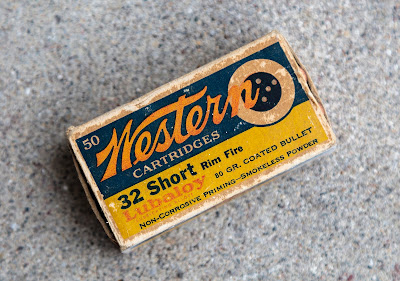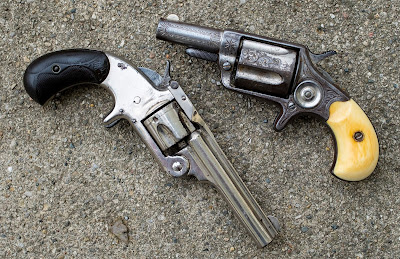I'm working on a blog post, so in the interim, have a picture of a .22/.32 Heavy Frame Target and a no-dash Model 34 Kit Gun. They're about thirty years apart, chronologically; one's an I-frame and the other's an Improved I-frame. This is tangentially related to the upcoming post.
Sunday, February 28, 2021
Gratuitous Gun Pr0n #197...
I'm working on a blog post, so in the interim, have a picture of a .22/.32 Heavy Frame Target and a no-dash Model 34 Kit Gun. They're about thirty years apart, chronologically; one's an I-frame and the other's an Improved I-frame. This is tangentially related to the upcoming post.
Saturday, February 27, 2021
Bad Numbers
Short Horizons
Fight for Fifteen, or Fight the Future?
"At a McDonald's drive-thru in a Chicago suburb, customers may notice something different about the voice that takes their orders for Big Macs and fries.The article touts the features and benefits of these ordering systems...
"Welcome to McDonald's, what can I get for you?" it asks in a welcoming, unmistakably feminine tone. While the voice sounds helpful, it's also stilted and monotonous enough for the average customer to figure out they're being served by a computer, not a human. It's a lot like Alexa or Siri, but for a drive-thru: a system driven by artificial intelligence that McDonald's is testing out to speed up its service."
""Humans sometimes forget to greet people, they forget, they make mistakes, they don't hear as well," Lucy Brady, McDonald's chief digital customer engagement officer, explained to CNN Business. "A machine can actually have a consistent greeting and remain calm under pressure.""...without mentioning some key ones: They'll never ask for a sick day or a smoke break...or a raise.
White Castle is introducing a burger-grilling robot.
— CNN (@CNN) July 16, 2020
The privately held restaurant chain has announced a partnership with the Pasadena, California-based startup Miso Robotics to introduce Flippy at one of its Chicago-area restaurants in September. https://t.co/wHO3aY8mtB
I guess burger flippers and fast food order takers should have learned to code.
Friday, February 26, 2021
Falling Off a Cliff
*...and ten years after that, a thousand bucks gets you Canon's full-frame mirrorless EOS RP, which sports a 6240x4160 resolution. The curve is leveling out, though, and the dwindling market means it will probably continue to do so.
"Listen, Legoland..."
Thursday, February 25, 2021
Graphical
.
Stay frosty!
Remember, everyone that drives faster than you is a maniac and everyone who drives slower is a moron.
"I'm prepared, you're paranoid, that guy over there's a sheeple."
Light Painting
"I was on a tripod, with a 200mm lens stopped down to F16, and the one you see here was shutter open for 2 minutes and 30 seconds using Kodachrome 64. I tried several time exposures as it was all guesswork and this was the best outcome. The light and color of the sky is a result of the long exposure. There is no light inside the cenograph, so after I opened the shutter, I trotted down, and while continuously moving so I didn't leave a shadow, I fired a hand held flash unit set for the correct distance repeatedly around the arch and on the stone in the center behind the flowers."You can go and see the finished result by clicking the quoted text.
Wednesday, February 24, 2021
Sympathetic Wince
"Tiger Woods is recovering following hours of surgery to repair comminuted open fractures in his right leg following a serious car accident in Los Angeles on Tuesday (February 23) morning. A comminuted fracture is when a bone breaks into several pieces and pierces the skin.
Orthopedic trauma surgeons at the Harbor-UCLA Medical Center had to insert a rod to repair his tibia and used screws and pins to stabilize the damage in his ankle and foot.
"Comminuted open fractures affecting both the upper and lower portions of the tibia and fibula bones were stabilized by inserting a rod into the tibia," Dr. Anish Mahajan said in a statement. "Additional injuries to the bones of the foot and ankle were stabilized with a combination of screws and pins. Trauma to the muscle and soft-tissue of the leg required surgical release of the covering of the muscles to relieve pressure due to swelling.""
Speaking to the gods & feelings in your belly.
Go and RTWT.
Tuesday, February 23, 2021
Today's Cat Picture Interlude...
Mars Needs Mic Mittens
 |
| Curiosity descent illustration from Wikipedia |
Monday, February 22, 2021
Sign of the Times
Cleanup on Aisle GBBL
"I took it over in 2013 after the others had to leave for professional reasons (can't blog AND be a paid gun writer)."Huh. I learned a lot from Farmer Frank, but he never told me about that part.
Sunday, February 21, 2021
Mouseguns, Then and Now
 |
| In its original black powder format in tip-up Smiths, the .32 Rimfire Short essentially duplicated the ballistics of .31 caliber cap & ball pocket revolvers. |
 |
| Reel West vs. Real West: Guns like this S&W .32 Single Action and Colt New Line .38 rimfire are a lot more typical of the period than the Peacemaker. |
Saturday, February 20, 2021
Friday, February 19, 2021
Plowing has happened.
Looking like this will be the year...
"House Bill 1369 did make progress this week. It passed out of the Public Policy Committee in the House and was approved by the Ways & Means Committee. Now it heads to a vote on the floor of the House this week, where it’s expected to pass and move over to the Senate."Funny how it easily greased through a Bosma-less House. I thought he was a conservative Republican and a friend of the Second Amendment?
Thursday, February 18, 2021
Counterintuitively Intuitive
Fountain pens, automatic watches, tube amps, revolvers, mechanical cameras...
There's a certain fascination with this bygone tech. I've gone on before about how I love the mechanical nature of the Leica III. If all you want to do is wind it up and click the shutter, that alone is enjoyable. Assuming, however, that you want to use it to actually make photographs, the process is a little more involved. Just getting the film into the camera with an old Barnack Leica can be an adventure for the uninitiated. (Get a trimming guide. You'll thank me later.)"...I like the process and the gear. The clicks as you select the aperture, the glide of the focus ring, the sense of coiling and storing energy as you thumb the winding lever for the next shot...
It's like driving stick shift; in this day of twin-clutch automatic transmissions, there's no performance advantage to the classic manual, but a certain amount of interaction with the machine is lost."But in the end, I'm assuming the reason someone wants to take photos on film is to, you know, actually take photos on film.
"But if this was about practicality and pragmatism, I wouldn't be using film in the first place. The 10S is a fine camera, but I might as well be using the DSLR, given how little bond there is between me and it."Nowadays I'd have been out there with that 10S, snapping away.
"The Minolta Maxxum 5 (and all other mid-level AF SLRs from its era) has a specification sheet that would literally melt the brain of any hypothetical time-traveling camera designer who finished his career in 1955 and died one day later. He’d blink at the Maxxum’s spec sheet with bulging eyes and a sweaty lip, wonder how focus can be automatic, scream when he sees multiple metering modes, and puke when automatic exposure bracketing is explained to him. He’d probably instantaneously die if he heard the electronic automated burst mode of a Nikon F90 (4.3 FPS). And then his ghost would desperately wail that “the camera must cost $10,000!” More on cost later.
“James,” you might say to me if we were on a first name basis, “I don’t believe you. How can a dorky mid-level autofocus SLR from the 1990s or 2000s be so much better than the legendary Leica M3 or the Nikon F3, or the Mamiya 7, or whatever other stylish camera everyone’s currently screaming at me to buy?”
Let me convince you. Those cameras that everyone wants you to buy aren’t as good as they say they are. They’re heavy, lacking in light meters or auto-exposure modes, or bracketing, or exposure compensation, or multiple exposure modes, or spot-metering or matrix metering or auto anything. These popular camera can’t do one tenth of the things that mid-level cameras from the time between 1995 and 2004 can do. In fact, the only thing that a Leica M3 does better than a Maxxum 5 is look good. The Leica has timeless style. The Maxxum 5 looks like it belongs to a dad at Disneyland who’s wearing a fanny pack and speed-walking shoes for entirely practical reasons."
Go and read the whole thing, if you need further convincing. But he ain't lying.
Wednesday, February 17, 2021
Tuesday, February 16, 2021
Weather Report
You can't let 'em generation gap you, dude.
Oh, boy! The Millennials are getting into it with the Zoomers now! Another chance for GenX to be all... https://t.co/hi93QLwdLa pic.twitter.com/AKr7vxWl7k
— Tamara K. (@TamSlick) February 16, 2021
Evergreen Conspiracy
"Where ever you find "handicapped access" signs and symbols and "YIELD" signs, you will also find a targeted site to be confiscated by the military.
Again, these signs are *European* in origin. When foreign sinage began to be injected into our own sign system in the 1960's the American people were told by the Department of Transportation, these signs were needful because of all of the *European* tourist entering our country, that we have to make them feel more at home while visiting our country! This fabricated *LIE* wrapped in an excuse is now exposed! In our research, these foreign signs are a major component in a scheme to set-up our nation, not for foreign *tourists*, but for an invasion of foreign troops! This was the real reason for their arrival in America, and it is continuing unabated. Actually, American road signs are becoming more and more confusing to understand as they shift to "wordless pictorials" and strange *stackings* of signage to accomodate the hidden codes for military operations.
Arrows pointing "UP" are a confirmed code symbol that identifys an important site and has been a regular feature at helicopter pick-up and drop zones."I can't help it, all the arrows pointing every which way in these diagrams make me think of a much more recent internet meme.
- The barcode scanners at Walmart and other big box stores are there to scan the marks that will be tattooed on the patriots who've been rounded up. They'll then store you in the Walmart garden center, which is why it has a big chain-link fence around it.
- As a matter of fact, anything with a big chain link fence around it, from basketball and tennis courts to big-city industrial facilities, is interpreted by these loons as a secret detention facility for patriots.
- Which is why they think barbed wire atop security fences points inward. That's a much more exciting reason than the actual one, which has everything to do with liability.
Monday, February 15, 2021
Dodged too late!
Since midnight last night we've probably gotten a solid five or six inches of snow here in Broad Ripple. I just went out and shoveled the walks for the fourth time since this morning (well, three shovelings and a sweeping) and it's still coming down at an inch an hour and not supposed to let up until the wee hours before dawn. I'll probably go out and hit it at least one more lick with the shovel before bed.
I was thinking to myself "Wow, it's been a while since we've seen this much snow all at once. There was December 2012, and then before that was...let's see, the big one in January of '09, not long after I moved up here."
It turns out that it's because I've had good luck on the last couple big snowfalls. In March of 2018 I only saw some sleet and freezing rain at gun school in Terre Haute while Broad Ripple got an eight-inch shellacking, and in January of 2014 I missed a foot of snow while I was visiting Knoxville.
So. Much. This.
 |
| via TactiComedy |
Naming Names and Petty Vindictiveness
Sunday, February 14, 2021
While we're on the topic of cats...
URGENT! Firearms Legislation Alert!
Bad Paneling
Saturday, February 13, 2021
More Human Than Human
Caturday
Friday, February 12, 2021
"Hipster Shotgun"?
"The Kalashnikov group, which produces the AK-47 assault rifle, has unveiled its hipster 'gadget gun' aimed at Gen Z customers who can't bear to be without tech.
The semi-automatic 12-gauge shotgun, dubbed the 'MP-155 Ultima', has a built-in HD video camera and computer to teach its users how to shoot.
The futuristic weapon, with a stylish composite body and an external display, can record your every move and transmit the information to your smartphone via Wi-Fi or Bluetooth."
Because it's never simple.
Thursday, February 11, 2021
Savage!
 |
| Savage Model 1917-20 |
 |
| Table of .32 production totals and serial number ranges in Savage Automatic Pistols |
The gun has an external hammer attached to which is a long firing pin that moves rearward with the hammer when the gun is cocked and forward when fired. The Savage is the first gun I’ve seen with this feature as opposed to the internally mounted, spring operated firing pins on the more modern guns I normally shoot.



























